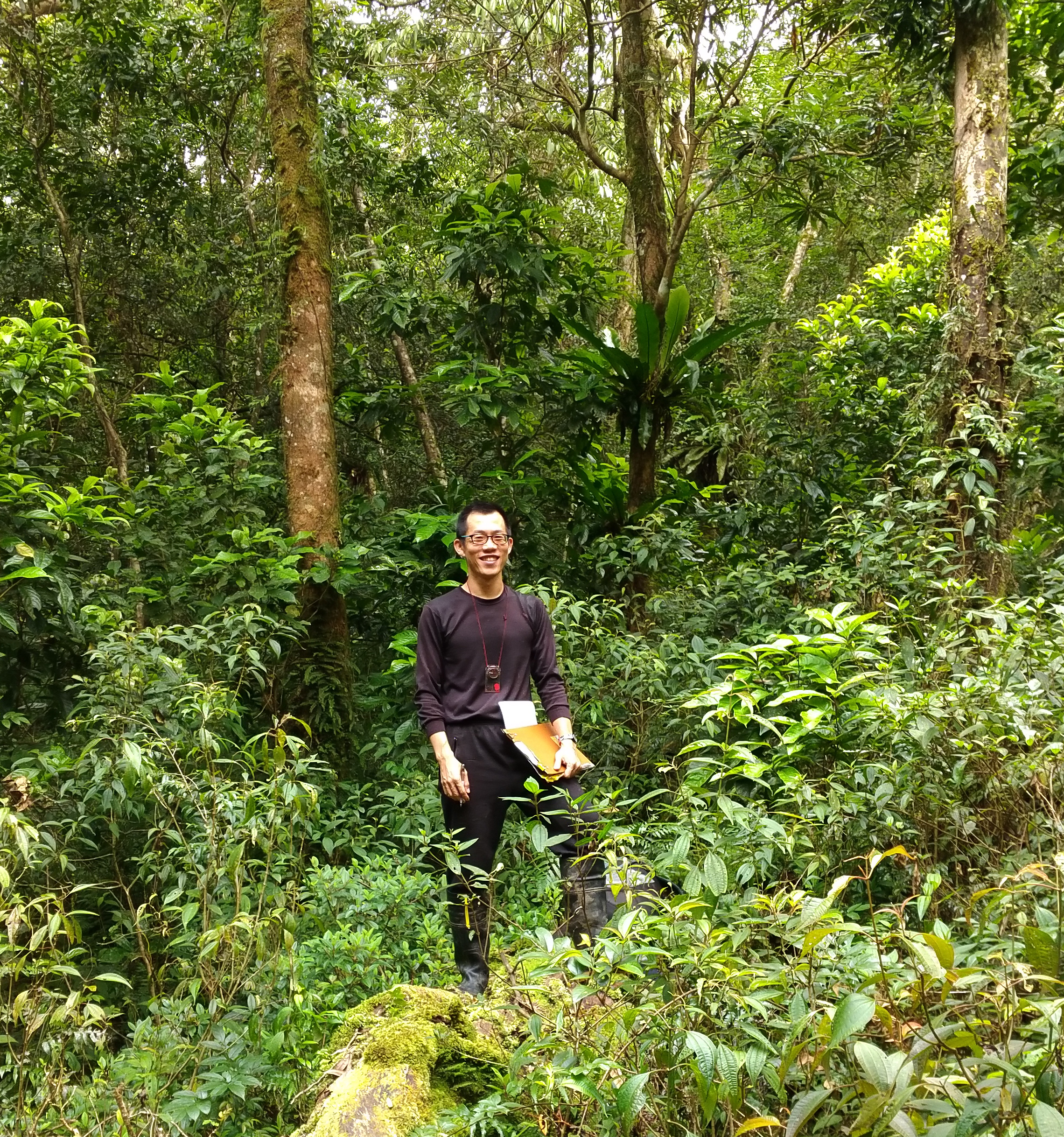by Deva Holliman

Chia-Hao Chang-Yang works on the 2019 annual mortality survey in a rainforest plot in Fushan, Taiwan. (Credit: Ting-Hsuan Kuo)
In 2003, Chia-Hao Chang-Yang, a researcher at Taiwan’s National Sun Yat-Sen University, began monitoring tree seedlings growing in a subtropical rainforest plot in Fushan, Taiwan. He and his colleagues tagged all tree seedlings from the new emergent sprouts up to 2 meters tall. They returned every six months to check on their growth.
For the next 16 years, Chang-Yang and his team returned and repeated the measurements. By the end, they had identified 13,818 seedlings from 40 different tree species.
Over all those years, only one seedling grew into a sapling taller than two meters. The other seedlings either stayed small—growing at a snail’s pace—or perished.
“I was very surprised to find that over 16 years of monitoring, only one newly recruited seedling reached two meters,” said Chang-Yang.
Chang-Yang began to wonder, where does a forest—and the massive trees that make it up—come from?
A Collaboration Across Continents
To answer this question, Chang-Yang and his Taiwanese colleagues collaborated with Sean McMahon, senior scientist at the Smithsonian Environmental Research Center (SERC). Their discoveries, published in a new study in the Journal of Ecology, reveal the truly tough odds an infant tree has to overcome.
In 2015, Chang-Yang came to SERC as a postdoctoral fellow in McMahon’s Quantitative Ecology Lab. Together, Chang-Yang and McMahon hoped to use statistical modeling to better understand how trees survive and grow to adulthood.
“We thought this was a great opportunity to see what happens in the strange window between a seed falling from a tree and it becoming a tree itself,” said McMahon.
The researchers used data collected from Chang-Yang’s 16-year seedling dataset to simulate the growth and mortality of thousands of seedlings. Focusing on the eight most abundant tree species, they built population models estimating how long it would take each seedling to reach two meters. They also calculated the probability a seedling would even survive that long. Effectively, they used data modeling to plant a virtual forest and watch it grow.
“We asked two basic questions that could offer us insight into what might be going on in this black box of seedling demography,” said McMahon. “First, how long, on average, does it take for a tree to grow two meters tall? Second, how many seeds does it take to make one two-meter tree?”
Those “Seedlings” Could Be Older Than Your Grandmother

Seedlings of the laurel Litsea acuminata, one of the species more likely to reach sapling stage in the new study. (Credit: Chia-Hao Chang-Yang)
Their findings demonstrated it could take anywhere from 57 to 40,000-plus seedlings to make a single two-meter tree, depending on the species. The likelihood seedlings would reach a mature size was lowest for species with slow growth rates and high seedling mortality. Species like the laurel Litsea acuminata did the best. Meanwhile, seedlings of Myrsine seguinii, a member of the primrose family, had to churn out over 46,000 seedlings to get one sapling.
Furthermore, their models predicted it would take 22 to 200 years for a germinated seed to grow two meters. Again, differences among species accounted for much of this. But things like rainfall, lack of sunlight, nutrient availability and disease could also stunt the growth of young trees.
“The message is simple,” said McMahon. “A small seedling you see in a forest could be older than your grandparents.”
There’s a significant “life history bottleneck” for trees before the two-meter height scientists traditionally use in global forest inventories. Even then, the lucky few that become two-meter saplings still have to survive into adulthood. The new data hammer home just how rare it is for small trees to become adults. Most small trees you see in the forest will never be able to reproduce successfully.
“The seedling-to-sapling transition ratio was extremely low in this subtropical rainforest,” said Chang-Yang. “Our analysis showed that the low survivorship at the early stage, together with the low growth rates of seedlings, contribute to this life-history bottleneck.”
But, he added, if scientists crack the code on the “rare exceptional individuals” that become adults, it could help predict how seedlings can shape entire forests.
Understanding how forests grow and survive is particularly important with accelerating climate change. Forests around the world are facing threats of droughts, heat waves, hurricanes and pest outbreaks. Continued research into seedling survival may reveal which species or forests may be most vulnerable to collapse—and which could weather the storm.
“Rather than studying the effects of climate change on tree death, I want to flip the problem and reveal how some trees are so good at surviving,” said McMahon. “Trees evolved to be [resilient]. Moving forward, I hope to better understand the ways that seedlings and mature trees are able to survive periodic stressful situations.”

